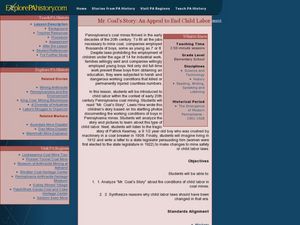Alabama Department of Archives and History
A Lifetime of Responsibilities: Child Labor in Alabama
Imagine children working long hours in factories, coal mines, and in the fields. Class members examine a series of pictures and read about early attempts to regulate child labor and current child labor laws.
Curated OER
Working for a Living: Child Labor Laws
Pupils research the working conditions in the late 1800's and the evolution of child labor laws. They discuss how the laws affect them today and if they are fair. They write a paper summarizing the laws and the view of the laws.
Curated OER
Child Labor in Maryland: An Historical Investigation
Tenth graders, after reading two excerpts about contemporary child labor situations, discuss two broad questions in detail along with the industrial boom following the Civil War conditions in the United States. They investigate how the...
Library of Congress
Child Labor in America
Students investigate child labor during the Great Depression. In this US policy lesson, students evaluate multiple layers of the social, economic, and political affects of policy during the Great Depression. Students will engage in 5...
Curated OER
Childhood Lost: Child Labor in the United States, 1830-1930
Working in groups, middle and high schoolers describe and discuss photographs depicting working conditions experienced by child laborers in the 19th century. They then write a persuasive paragraph supporting an amendment to regulate the...
Curated OER
Child Labor Laws in the United States and the State of Nebraska
Students examine child labor laws. In this social justice activity, students compare and contrast child labor laws of the United States and the state of Nebraska. Students research primary sources and complete the included analysis...
Curated OER
Child Labor during the Industrial Revolution and Now
Fifth graders research topic of child labor by studying Industrial Revolution, read about child labor laws, and examine countries where child labor still exists today. They then choose single question to research from list, and create...
Curated OER
Child Labor Laws in America and Nebraska
Students research child labor laws in Nebraska and America. In this child labor lesson, students examine primary and secondary sources regarding legislation on child labor and create posters that highlight the laws of 1907 and 1910.
Syracuse University
American Industrial Revolution
While the Industrial Revolution may have fueled America's rise to the top of world markets, the child laborers often faced dangerous conditions. Using primary source images and other information, scholars consider what these children...
Curated OER
Child Labor in the Carolinas
Fifth graders explore child labor and how children were exploited and used in the work place. For this Industrial Revolution lesson, 5th graders research child labor by reading, looking at photographs and drawing conclusions then sharing...
Curated OER
Child Labor in America
Learners interpret historical evidence presented in primary and secondary sources. In this child labor instructional activity, students examine the issue of child labor and determine how citizen...
Curated OER
Child Labor Today and Yesterday
Students examine the child labor laws of the present and past. They discover how technology added to the problem of child labor during the Industrial Revolution. They read articles about how other countries deal with this problem.
Center for History Education
Methods of Reform: The Lowell Mill Girls
Although the girls and women who worked in the Lowell Mills are not often seen this way, they are the forbearers of the American labor movement. Pupils examine primary sources, including testimony about life at Lowell and labor laws, as...
Curated OER
Mr. Coal's Story: An Appeal to End Child Labor
Pupils read about child labor in the early 20th century. In this Pennsylvania history activity, students read a story about child labor and discuss reasons why child labor laws should have existed during the early 20th century.
Roy Rosenzweig Center for History and New Media
Labor Unions in an Industrializing U.S.
Have class members eager to enter the workforce? They'll be glad to learn that things aren't how they used to be. Have your young historians examine then discuss four primary source images related to the negative effects of...
Curated OER
Three Centuries of Child Labor In America
Fifth graders investigate the history of child labor that is found in America. They use a variety of resources to conduct research. Students create cause and effect arguments using the information that is found. They also compare and...
Curated OER
Teaching With Documents Lesson Plan: Photographs of Lewis Hine: Documentation of Child Labor
High schoolers interpret historical evidence presented in primary and secondary resources. In this child labor lesson, students examine photograhs by Lewis Hines and discuss the implications of child labor in America.
Curated OER
Photographs of Lewis Hine: Documentation of Child Labor
Young scholars use the Archival Research Catalog to complete assignments and activities about Lewis Hines and the National Child Labor Committee.
Curated OER
What is Child Labor?
Students examine the topic of child labor in history. They discuss jobs that children their age would have done before child labor laws. They decide on an action to take on Labor Day to share what they have learned with others.
National Woman's History Museum
The Triangle Shirtwaist Fire
On March 25, 1911, 146 garment workers died in the Triangle Shirtwaist Factory fire. Class members use primary source documents to research the tragedy and how it lead to the creation of labor unions and new labor laws. As an exit...
Curated OER
History of American Child Labor
Students study the historical and social issue of child labor. They examine the photographs of Lewis Hine to see evidence of child labor and decide how the photographs depict the historical impact of the practice. They write a letter to...
Curated OER
International Response to Child Labor Issues
Students examine effectiveness of international response to child labor problems. Students describe problem as international community sees it, evaluate analysis and response tactics of International Labor Organization, and determine...
Curated OER
Child Labor and Social Protest
Students explore child labor of the 1900's and compare it to its existence in countries around the world today. Several activities are included including Web research, video presentations, and group projects.
Center for History Education
The Triangle Shirtwaist Factory Fire: Is Anyone to be Punished for This?
The stories of bodies falling to the pavement and girls dying in their seats echo to the present day. The New York City Triangle Shirtwaist Factory fire—which killed 147 people, mostly young women and girls—galvanized the labor movement...

























